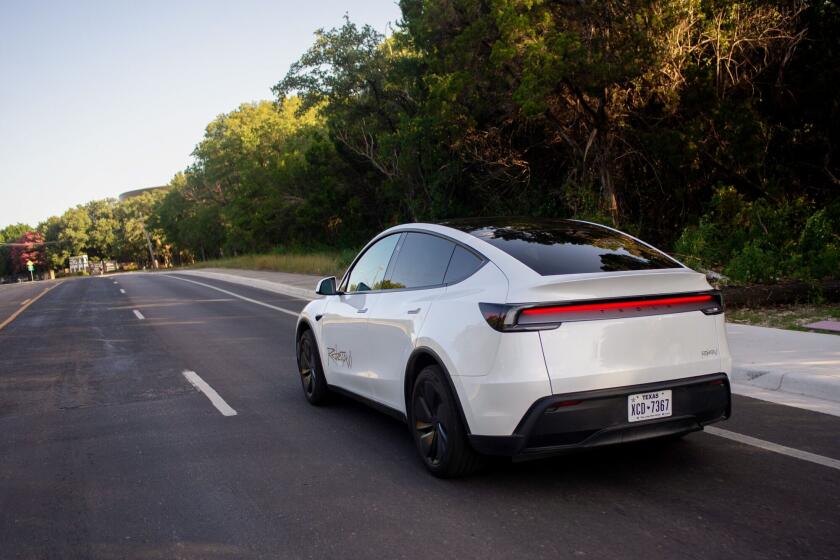Bike To the Future : The industry’s biggest trade show, in Anaheim, offers a look at the latest advances and the gadgets that companies are trying to pedal.
- Share via
ANAHEIM — Interbike, the bicycle industry’s biggest trade show, came and went at the Anaheim Convention Center over the weekend, leaving a trail of broken buzzwords and twisted technical terms.
Titanium lugs, metal matrix, double-butted graphite composites--casual bystanders might have been excused for thinking they had stumbled into a convention of rocket scientists. But the dealers at the 10th annual show were lapping it all up, from the latest in water bottle design to the newest ultra-ultra-lightweight frames.
Weeding through the jargon in search of the real news is at best an inexact science, but a a walk through the immense show (more than 600 exhibitors) resulted in a few impressions.
* Light, lighter, lightest: At the high end of the performance scale, the quest to shave ounces continues, and damn the expense. Experimentation with frame materials that combine strength and low weight is moving in several directions, with molded carbon and graphite composites, new metal alloys and carbon fiber dominating the high end.
Trek has introduced two new 5,000-series road bikes that boast a new composite frame that is, according to the company, the lightest now in mass production (at 2.44 pounds, contrasted with 2.53 pounds for the Kestrel 200 EMS). Specialized, meanwhile, unveiled its new M2 mountain bike frames, made of a newly developed (and weldable) aluminum “matrix” that allows for tubes of a much smaller diameter than the aluminum tubes of old.
The M2 bikes are part of the new top-of-the-line S-Works mountain bike series from Specialized, the company that produced the first production mountain bike back in 1981. The S-Works line culminates in a new carbon fiber bike with strong, light and expensive titanium lugs (lugs hold the tubes together). The price, fully outfitted? A mere $6,500 or so (the lugs alone run $1,800). The company will only produce about 250 of the frames.
* Goodby, seat post?: Another continuing trend in mountain bikes is the introduction of increasingly complex suspension systems. Shock absorbers on the front forks are already almost de rigueur for higher-end bicycles, while rear-end suspension systems are starting to creep in, as evidenced by Trek’s new 9000 series bikes.
Suspension is not new, but it is finally catching on. “It’s nice to see so many suspension bikes out there,” said Joel Groendal of Greendale Bicycle Co., which has been making suspension bikes for nine years. “They used to point and laugh at us,” Groendal said, but no more. Bicycling Magazine recently named the Sling Shot the fastest mountain bike-- period.
While general acceptance of the suspension concept is on the rise, disagreements over its applications are cropping up. The most prevalent suspension systems are patterned after motorcycle shocks, which some say are inappropriate for bicycles. With motorcycles, the machine constitutes the bulk of the weight and the rider weighs relatively little; the opposite is true in bicycling, as critics point out.
Standard rear shocks in particular, critics contend, absorb too much of the rider’s pedal power and are inefficient. Advocates counter that rear shocks keep the back tire in more constant contact with the ground, greatly improving traction.
The most radical suspension system is that designed by Allsop, just this year going into mass production. The Allsop holds the seat with a gently curved horizontal support, like a diving board. It can be added to traditional tube frames, but several smaller manufacturers are starting to build their bikes around the item.
Its big advantage, according to designer Mike Allsop, is that it cushions the ride without violating the integrity of the frame, as most bicycle suspension systems do. Another benefit is that it eliminates the need for the aerodynamically unsound seat post.
There are applications for road bikes as well. Most composite bikes now simply emulate the basic design of a tube-frame bike, but the elimination of the need for a seat post will allow more aerodynamic designs (a Zipp-Compositech bike designed with the Allsop system was perhaps the most radically designed bike in the show).
Also, the addition of suspension to road bikes will allow greater use of composite disk wheels (which do not have the “give” of spoked wheels) and higher tire pressures. Also, according to Allsop, the compression possible with his seat design allows better cornering.
An idea to watch in the next few years . . .
* Market-chasing: High-tech advances in materials and suspension are great for performance-seekers, but what about the rest of the biking public?
Bike-makers are asking the same question. The exploding mountain bike market, which carried the industry to glory in the ‘80s, peaked in 1989 and has since dropped slightly to an apparent plateau.
Makers slowly realized that many mountain bike-buyers never take their bikes onto the dirt but are attracted instead to the increased safety and comfort of the upright design and big tires. So they came up with the hybrid, which looks like a mountain bike, only with skinnier and smoother tires and a lighter frame. The bikes are sturdy enough for a leisurely ride on a dirt fire road but are designed mainly for tooling around town. The push to hybrids continues with the 1992 lines, as several makers introduced new models at Interbike. A number of manufacturers also sense a new and growing market for bikes designed for commuting.
Richard Moran of Trek said the company recently had a show of its new line, including several new bikes designed just for the European market--hybrid bikes equipped with racks, fenders and lights. To Trek’s surprise, American dealers showed a lot of interest. “Dealers are seeing some kind of growth in the commuter market,” Moran surmised.
Specialized, meanwhile, asked its designers to come up with the ultimate commuter bike, and the experimental prototype, dubbed the Metro, was unveiled at Interbike. The futuristic-looking bike includes internal drum front and rear brakes that are operated with one lever (“to leave the other hand free for carrying groceries,” the press release says), a kickstand built into the rear disk wheel and a cable and lock that retract into the molded bike frame.
“Who is going to buy a Metro bike? Not Americans, at this point,” said Chris Murphy, a designer for Specialized. But, that might change, he said, by the time such a bike could be put into production.
* Family biking: Ten years ago, Burley became a pioneer in the manufacture of bicycle trailers for taking the tykes along on a ride, and that remains a lucrative business for the worker-owned cooperative. Five years ago, it began building tandem bikes, which also has become a successful line.
It was largely alone then, and its Duet model may be the biggest selling tandem on the market (the company does not make single bikes). Now, suddenly, many of the big makers are building tandems, a trend that was in evidence at Interbike.
“A lot of companies are realizing that family cycling is really taking off,” said Rob Templin of Burley. “In the past, if you wanted to take the family, it was really difficult.”
Spokesmen for several companies said that cyclists who came into the market in the past few years are now looking to share their enthusiasm with significant others. Tandems allow couples to ride together without sacrificing a workout, even if one rider is stronger than the other.
Burley even sponsors an annual race in its home town of Eugene, Ore., for those looking for more than a cruise along the beach. And yes, there are tandem mountain bikes. Prices for Burley bikes range from $1,150 to $2,095, with the Duet coming in at $1,395.
* Two-wheel drive: One of the more interesting new products unveiled at Interbike was the two-wheel drive mountain bike line offered by St. Louis-based Legacy Bicycles Inc. The bikes have a standard chain drive on the back wheel, but transfer some of that power to the front wheel with a flexible shaft drive. Time will tell if this is more than a gimmick.
* Final notes: While most of the exhibitors were banking on change to bring in customers, the Italians continue to rely on supreme craftsmanship and classic designs. Amid the high-tech salesmanship of Interbike, a walk through the Italian pavilion and a visit to exhibits of the great frame-makers--De Rosa, Pinarello and the Belgian Eddy Merckx--was refreshing.
Meanwhile, it looks as if the flashy neon colors of the past few years are out and more subtle hues are in. Some of the best-looking bikes: Breezer mountain bikes by Joe Breeze Cycles, with paint jobs patterned after the old Schwinn Excelsiors of the ‘30s. A nod to mountain biking’s roots by Breeze, one of its pioneers.
More to Read
Inside the business of entertainment
The Wide Shot brings you news, analysis and insights on everything from streaming wars to production — and what it all means for the future.
You may occasionally receive promotional content from the Los Angeles Times.










